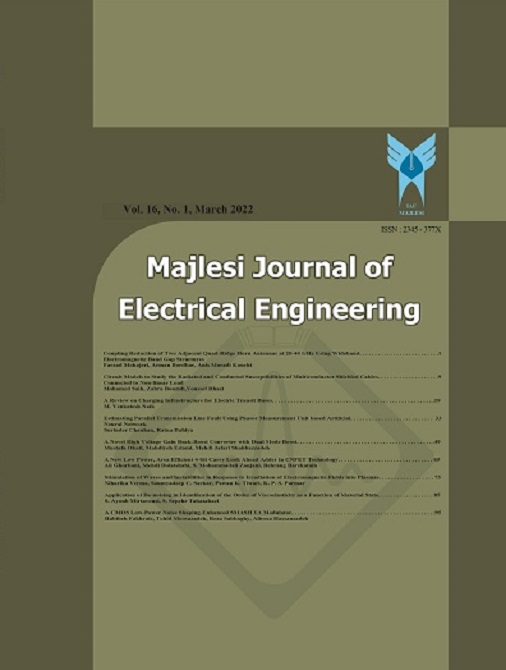[1] MI Chidean, E Morgado, M Sanromán-Junquera, J Ramiro-Bargueno, J Ramos, and AJ Caamano, "Efficiency and quality of data-coupling cluster reconstruction for large-scale self-organizing WSNs", IEEE Sensors Journal, 16, pp. pp. 5010-5020, 2016.
[2] Jia, H. Zhu, S. Zou, and P. Hu, "A Dynamic Cluster Head Selection Method for Wireless Sensor Networks", IEEE Sensors Journal, Vol. 16, pp. 2746-2754, 2015.
[3] Tareq, R. Alsaqour, M. Abdelhaq, and M. Uddin, "Energy cost algorithm for artificial swarm-based mobile ad-hoc networks," Wireless Communications and Mobile Computing, Vol. 2017, 2017.
[4] -H. Liu, V.-T. Tennessee Van. Nguyen and Y.-S. Luo, "Heuristics for Maximizing Data Aggregation Lifetime in Wireless Sensor Networks", arXiv-Preprint arXiv:1910.05310, 2019.
[5] N Srikanth and MS Ganga Prasad, "An energy-efficient clustering protocol using genetic algorithms in wireless sensor networks", Journal of Engineering Science and Technology Review, Vol. 11, 2018.
[6] ID Saeedi and AK M Al-Qurabat, “A systematic review of data aggregation techniques in wireless sensor networks,” Journal of Physics: Conference Series, 2021, p. 12.012194.
[7] K. Idrees and A.K.M. Al-Qurabat, "An Energy-Efficient Data Transmission and Aggregation Protocol in Nebula Computing-Based Periodic Sensor Networks", Journal of Network and Systems Management, Vol. 29, pp. 1-24, 2021.
[8] Ramezanifar, M. Ghazvini, and M. Shojaei, "A New Data Aggregation Method for WSNs Based on Surface Mining," Wireless Networks, Vol. 27, pp. 41-53, 2021.
[9] Shobana, R. Sabitha, and S. Karthik, "A cluster-based system data aggregation model (CSDAM) for real-time data processing in large-scale WSNs", Wireless Personal Communications, pp. 1-19, 2020.
M Alam, AA Aziz, S Latif, and A Awang, "False-aware data clustering for network data reduction in wireless sensor networks", Sensors, Vol. 20, p. 1011, 2020.
Verma and D. Singh, "A Local Aggregation Scheme for Data Acquisition in Periodic Sensor Networks", International Journal of Engineering and Advanced Technology, Vol. September 2019
S Yadav and RS Yadav, "Redundancy Elimination During Data Aggregation in Wireless Sensor Networks for IoT Systems", Recent Trends in Communications, Computing, and Electronics, Ed.: Springer, 2019, pp. 195-205.
N SreeRanjani, A. Ananth, and L. S. Reddy, "An energy-efficient data acquisition scheme in wireless sensor networks using an adaptive optimization algorithm", Journal of Computational and Theoretical Nanoscience, Vol. 15, pp. 3456-3461, 2018.
Kiruthiga, T. and Shanmugasundaram, N., "In-network Data Aggregation Techniques for Wireless Sensor Networks: Research, Computer Networks, Big Data and the Internet of Things", Editors: Springer, 2021, pp. 887-905.
Hasheminejad and H. Barati, "A Reliable Tree-Based Data Aggregation Method in Wireless Sensor Networks," Peer-to-Peer Networks and Applications, Vol. 14, pp. 873-887, 2021.
Gavel, R. Charitha, P. Biswas and AS Raghuvanshi, "Data Fusion-Based Data Aggregation and Retrieval Techniques for Fault Detection in Wireless Sensor Networks," Computing, Vol. 103, pp. 2597-2618 , 2021.
Acharya, S. Chattopadhyay, and R. Roy, "Energy-aware virtual backbone tree for efficient routing in wireless sensor networks," in International Conference on Networking and Services (ICNS'07), 2007, pp. 96-96.
Asgarnezhad, and S. Amirhassan Monadjemi. "An effective combined method for data aggregation in WSNs." Iran Journal of Computer Science, Vol. 5, No. 3, 2022, pp. 167-185.
Asgarnezhad and Javad Akbari Torkestani. "A survey on backbone formation algorithms for Wireless Sensor Networks:(A New Classification)." in 2011 Australasian Telecommunication Networks and Applications Conference (ATNAC), IEEE, 2011, pp. 1-4.
Asgarnezhad and S. Amirhassan Monadjemi, and M. Soltanaghaei. "An application of MOGW optimization for feature selection in text classification." The Journal of Supercomputing, Vol. 77, 2021, pp. 5806-5839.

